Bathroom - this room is special. It is here that most people relax and take water procedures. And it's no surprise that they always approach more seriously. Today you can use modern technology, with the help of which you create really cozy rooms. You can make the floor in the bathroom and not only get a practical and wear-resistant flooring, but also enjoy a unique design.
Self-leveling floors: what is it?
Self-leveling floors are a liquid, or rather a special mixture, which is poured onto the base of the base. When the mixture dries, a pleasant to the touch surface is obtained, which is compared with a smooth floor tile.
Mixtures that are used to create self-leveling floors have the property of self-leveling. This greatly facilitates the task for those who have not yet had experience in installing such floors. Making the floor in the bathroom by hand is not at all difficult. For success, it is necessary to strictly follow the technology of applying the mixture and pre-carefully prepare the base.
Advantages of self-leveling floors
These floor coverings have many advantages. The first thing that can be said about them is the very high performance characteristics that distinguish the bulk floor. In the bathroom, this is especially true: in this room is constantly increased level of humidity.
In addition to excellent moisture resistance, this modern floor covering is characterized by high ecological compatibility, high level of strength, resistance to various mechanical damages or deformations. Also among the advantages are antistatic, excellent thermal conductivity, high resistance to chemical attack. Also, these floors provide very broad opportunities for creating design effects. See how the filling can look like. The photo can not convey the depth of the picture - in reality it looks fantastic.
We make a bulk coating in the bathroom
According to their characteristics, pourable coatings are an ideal choice for bathrooms where there is constantly increased humidity and various cleaning and cleaning agents are used. Also in these rooms should always be the most comfortable temperature. You can create all this with the help of unique self-leveling floors.

We prepare the basis for work
Before proceeding with installation, it is necessary to carefully prepare the rough floor. So, the process preparatory work includes three stages. At the first stage, the concrete base is thoroughly cleaned from various dirt and dust. Next, the floor is inspected for various defects. If something could be found, then a crack or cleavage must be removed.
The next stage of work - applying primer coating in two layers. Pick up the primer on the basis of what the base in the bathroom. For weaker floors, mixtures with a higher penetrating power are used.
We select materials
In order to pour the filler floor in the bathroom with your own hands, you should buy a polymer mixture, as well as a finishing coat. Also, if you plan to do not just floors, but something designer, then you also get design elements.
Today, in building supermarkets, you can easily and inexpensively find various colored polymer compounds for the bulk floor, which will help decorate any Designers today also create a unique bulk filler floor for the bathroom. The photo can be seen in the article.
When choosing materials for floor installation, it is very important to purchase mixtures only from reliable manufacturers. Only so you can buy a real, high-quality product and get a reliable floor as a result. Besides the right choice then it is necessary to study the instruction and prepare the bulk mixture as indicated by the manufacturer. Only in this way can you get a solution of the necessary density, with which it will be very easy to work.
Mixtures for bulk floor
To arrange the floor in the bathroom apply several products. These are solutions based on polymers and cement, crushed stone or sand. These compounds are most suitable for the creation of a quality base base.
In addition to the base, finishing mixtures are also used. Here in the basis of only a polymer. For bathrooms, polyurethane or epoxy finish coatings are best. Floors based on these solutions will have maximum wear resistance and excellent decorative characteristics. Take a look at how effectively the floor in the bathroom looks. The photo below is made after a year of using the floor. As you can see, there are not a single scratch on it.
Required Tools
To install bulk floors, the home technician only needs a spatula and a special roller with needles. The spatula will help to evenly spread the mixture over the entire surface of the base, and the roller - to remove air bubbles from the solution. 
Filling technology
First of all, prepare the solution. In a pre-prepared container, all components are covered and using a mixer or a drill with a stirring nozzle is thoroughly kneaded. As a result, a homogeneous solution should be obtained. Then, the resulting thick liquid is poured onto and leveled off the layer so that the thickness over the entire area of the room is approximately the same.
It is important to know that floor installation work must be carried out within the strict temperature range. Work is allowed at a temperature of +5 to +20 degrees. Also there are requirements and to the level of humidity - not more than 60% is allowed. If these important conditions are violated, nothing terrible will happen, but the coating will be much longer to freeze.
If everything is done correctly, the thickness of the layer is the same, then you can finish the work on this. For complete drying the coating will take at least 12 hours. However, this is only the base surface. There is still a finish covering. Filling technology is the same.
The floor in the bathroom can be made by everyone. This is a simple floor, for which only a flat concrete screed is needed.
It is important that at the time of the drying of the coatings, the inflow of fresh air is limited. If you do not, then in time the floor just cracked.
On the disadvantages of filling
The first thing that these polymeric floors scold for is high prices for the mixture. The price is really much higher than that of a tile or traditional linoleum. Another disadvantage is the rapid drying out. If a mistake was made during the filling, there is very little time to eliminate it.
That's all the disadvantages. For those who decided to make a bulk floor in the bathroom, feedback about the operation modern technology positive. All those who use these floors, confirm the high durability and durability.

We decorate the flooring
These floors have very wide possibilities for decoration. Some covers are almost works of art. If the home master has a sense of beauty, then he will be able to give the bathroom a special look. There are several ways to decorate a floor covering.
The first method involves superimposing an image on a base layer on a special film. It is necessary to stick it very carefully on the base, and then apply the finish part.
A more advanced owner of a house or apartment uses the services of professional artists who create not just images, but voluminous pictures.
You can make a durable and beautiful coating, but it will be monophonic. This filler floor in the bathroom also looks very, very impressive. To do this, a dye is added to the polymer mixture.
 So, pouring liquid floors is a simple operation. The result is simply perfect, and the wide possibilities for decorating and decorating make liquid coatings an excellent option not only in the bathrooms, but also in other rooms.
So, pouring liquid floors is a simple operation. The result is simply perfect, and the wide possibilities for decorating and decorating make liquid coatings an excellent option not only in the bathrooms, but also in other rooms.
Repairing the floor in the bathroom with your own hands is one of the most complex technological processes in the arrangement of an apartment. At this stage all communications are closed, the screed and waterproofing are done. Repair is carried out taking into account the high humidity of the room, which further complicates the work. Here we will figure out how quickly, qualitatively and technologically it is right to make the floor in the bathroom with your own hands.
Qualitative characteristics
First, let's define what requirements the new flooring should meet. Based on this, we will be able to choose the right coating for finishing the floor.
- Non-slip and safe;
- Easy-going;
- Water resistant;
- Warm;
- Beautiful;
- Wear-resistant.
The right choice of flooring is not all. It is important to observe the technology of laying the selected material. And then the floor will serve you for many years.
Types of flooring
Practicality, moisture resistance and combination with the interior chosen by you - these are the basic requirements for any floor covering for the bathroom. Consider the most popular, interesting and worthy of attention options.
Ceramic tile
An excellent option of finishing is the tile on the floor in the bathroom with your own hands. Today it is the most popular option of finishing. Ceramic tiles do not deform with time, it is easy to wash and almost impossible to spoil chemical means. In order for the floor in the bathroom to be non-slip, we recommend that you avoid tiles with a glossy surface.

Linoleum
Linoleum is one of the cheapest options for flooring. For the bathroom you need to buy linoleum on a moisture-resistant substrate. A rough surface is another plus in favor of such a coating.

Filling floor
Today, this option is becoming more popular. The floor is a polymer, which in the liquid state flows evenly over the floor, and then freezes. This floor is absolutely moisture resistant and durable. The water heated floor in the bathroom with their own hands is often combined with a filler. Its main advantage is an absolutely smooth non-slip surface, and a disadvantage is a high cost.

Laminate
Laminate - not the most suitable coating for the bathroom. If the water remains on this material for a while, it will last only a few years. Therefore, even moisture resistant laminate you will have to wipe dry after every shower or bath.

A rock
Natural stone is well suited for finishing the floor and walls in the bathroom in terms of its durability and moisture resistance. However, the stone is very slippery and cold, so walking with bare feet on it is simply not safe, which, you see, is not very convenient.
Tree
The wooden floor in the bathroom, made by own hands, looks very stylish, beautiful and noble, but, unfortunately, the moisture-resistant qualities of the tree leave much to be desired. Such sex is not the most practical or profitable option, but has the right to exist.

Repair work
Repair work to replace the floor in the bathroom can be divided into four main components:
- Floor preparation
- Waterproofing
- Screed
- Finishing the floor
Floor preparation
Usually the bathroom already has a coupler. Therefore, during the repair of the floor, we first of all remove all the old finishing materials. To ensure that your repair has lasted for many years, this step must be performed as carefully as possible: remove all paint, putty and other dirt from the floor. Carefully walk through the areas where the coupler is adjacent to the walls. If you hear an empty sound when knocking on the old floor screed in the bathroom, it means that there are cavities in the floor, this screed needs to be changed completely. If the previous screed is in good condition, then cover all cracks and unevenness with tile glue and leveling compound, and then start repair after completely drying them.
The last stage of preparing the floor for repair is the treatment of the entire surface with a primer.
Waterproofing
The waterproofing layer is made in several ways and different building materials. Here are the three most common and worthy of attention:
- Pasting
This option is suitable for the bathroom, where it is necessary to waterproof not only the floor, but also the vertical surfaces. With this method of waterproofing, the final work will be similar to a bowl with a depth of up to 1.5 m. Suitable for lay people and beginners in the repair world.
- Bitumen
Bitumen, or rather the bituminous mixture is applied to the floor with a soft roller or bowl. This is a cheap option, but the lifetime of such a waterproofing usually does not exceed five years.
- Coating
The coating material makes an ideal waterproofing of the floor, so it is so successful. Before applying it to the joints, a waterproofing tape should be placed. Then the waterproofing is applied, in consistence resembling a liquid dough. It is convenient to spread it over the surface with a dense roller or a construction spatula. As in the case of pasting, such a waterproofing can cover the walls, but at a height of not more than 10 cm.

Screed
First you need to decide on the height of the floor screed in the bathroom. For this purpose, the building level - laser or water - is suitable. On the perimeter of the renovated room a smooth line is planned, along which the screed will be made. The warm floor in the bathroom with your own hands is installed at this stage.

After that, you will find racks and rope beacons.
Then the cement mortar for the screed is poured into the space between the slats and leveled along the beacons.

Remember: The screed should dry itself, in a natural way. The system will have to be switched off during the hardening of the screed.
Tile in the bathroom
In our article on how to make the floor in the bathroom with your own hands, we will not talk in detail about the methods of laying all finishing materials. Let us dwell only on the most common - tile for the floor.
Tiles on the floor in the bathroom, laid by own hands - this is both a practical, durable option, and an affordable solution to the pressing issue.
For self-repair you will find useful:
- Building level;
- Putty knife;
- Container for mixture;
- Cross-dividers.
Before you start laying the tiles on the floor, you need to determine which direction you will put it, whether you need to cut it and how to observe the symmetry in the drawing.

Tile adhesive is applied to the tile or to the floor. In the course of work, plastic crosses are used to maintain a flat width of the joints between the tiles.
The final stage is the grouting of the seams. It is made after removing all contaminants from the tile, including - and excess glue. The grout is applied with a rubber spatula or a rag.
Video
On the video you can see how to make the floor in the bathroom with your own hands:
The bathroom is a very special room in an apartment or a private house. Specific operating conditions of this room impose and increased requirements for all elements of its design. Especially a lot of trouble brings floor covering - in fact with a high probability it can regularly get a significant amount of water. What if his condition causes fear, if there is no certainty that it can become a reliable barrier to moisture if the surface crumbles and flakes off? Nothing remains, how to fill the floor in the bathroom again - half measures in this matter can not do.
Very often, the floor is reloaded, and when the general repair is done in the bathroom, if there is a desire to update the floor covering, make it in general style with the decoration of the room. To build a floor in height is not the most acceptable solution for several reasons, hence, again the only way out can be a new screed or polymer polymer.
So, what are the requirements for the floor in the bathroom, and what sequence of work should be adhered to.
Characteristic features of the floors in the bathroom
So, what is the difference in the floors in the bathroom from the coatings in other areas of the apartment:
- First of all, the bathtub is never ruled out to spill a lot of water on the floor. The coating should effectively retain water, do not miss penetration into the thickness of the material and, even more so, to the interfloor overlapping.
- In the bathroom, almost always high humidity. This means that the floor material must have a certain moisture resistance, do not disintegrate under this influence, even in such extreme conditions, remain durable.
- In this room are always located engineering communications - water supply pipes, sewerage, sometimes - and heating systems. In most cases, they pass through "transit", through interstorey floors - and this is another ready-made channel for moisture penetration, which must be reliably blocked.
- Plumbing equipment has considerable weight - it is a question of bathrooms, toilets and m.. Hence, the floor must have good strength characteristics in order to easily cope with such static load. Dynamic loads can be small (several people come to the bathroom at once), but if you consider that sometimes there is a washing machine here, if the room is well ventilated, then the coating must withstand the vibrational effect.
- The floor in the bathroom should be slightly below the general level of coverings in the apartment - in case of water spill it does not spread through the rooms.
- If in all rooms, as a rule, the floors are taken out to a strict horizontal line, then in the bathroom it is better to create a small slope towards the open accessible area - this will facilitate, if necessary, water harvesting from the surface.
- Sometimes, if specific conditions permit (most often in case of individual construction), it makes sense to arrange drainage of water from the floor surface by organizing a slope toward the ladder connected to the sewer by a pipe located at a certain angle. It is clear that in a multi-storey building this is practically impracticable.
- And, at last, floors should be, whenever possible, as much as possible comfortable - it is good, if there is an opportunity to provide effective thermal insulation or to arrange system of heating of a floor.
To fulfill all these conditions, the best way is to fill the new floor.
Primary preparation of the bathroom
- It is clear that in the first place in the bathroom, all the plumbing equipment is dismantled and taken out, so as to completely clear the floor area.
- The next stage is the dismantling of the old coating. Here it is better not only to remove only the layer ceramic tiles or other decorative coating. Any literate specialist to the question whether it is possible to leave the old screed, answer categorically "no." This is explained quite simply:
Firstly, the coupler that served a considerable time almost always has some latent or obvious defects.
Secondly, no one knows how high-quality material has been used to install it, and how long it will last.
Thirdly, how to determine the state of the slab itself? Perhaps it also needs some repair, drying, hardening, processing anti-mold compositions and the like.
Fourth, the waterproofing must be carried out independently so that there is full confidence in its effectiveness.
And, fifthly, pour new coating on the old screed - it almost always means exceeding the floor height in the bathroom.
- So, the old screed needs to be removed. Make it a puncher, very carefully, so as not to disrupt the integrity concrete slabs grounds. The process is very laborious, associated with a large amount of construction debris, but necessary.
- After dismantling and thorough cleaning of the surface, its revision is carried out. It must be repaired with a repair composition (cement or polymer-sand, a special sealing cord, etc.) possible cracks, cracks, in features - at the joints of the floor and walls. The maximum attention is given to the interlace seams, if any, to the passage points of the sleeves with the pipes. It happens that once found drilled holes in the plate - they require mandatory sealing.
- The cleaned surface undergoes priming, and for this purpose it is better to use impregnating compositions with aseptic action to prevent the development of colonies of microorganisms (mold, fungus, etc.).
When the soil gets wet and the surface dries, you can proceed to further actions - the waterproofing of the substrate.
Work on the waterproofing of the concrete floor base
The importance of the primary waterproofing of the floor in the bathroom can not be overemphasized. This work will require special care - it directly affects the quality of the rest of the coating.
What methods are most applicable for this room?
1. Rolled waterproofing is the oldest and most proven way. Use for this purpose roofing material, it is better that it was a modern type - with a self-adhesive base or with a layer of special mastic for styling. The coating will be even better if the roofing paper has rubberized layer.
- First of all, the floor must be covered abundantly with a layer of bitumen mastic. Especially do not feel sorry for her in the corners, in the places where pipes pass. Not only the floor surface is treated, but also the lower part of the walls, to a height of at least 200 mm.
- Bitumen mastic should never be replaced with tar. With all the external similarity, the tar coating is not longevous - the material quickly dries up and cracks, especially when in contact with concrete.
- When the dried mastic will allow the movement along the floor, the roofing material is covered. In the case of self-adhesive material, a paper substrate is removed, the sheets are rolled by a roller after laying. If the roofing material has a layer of mastic applied, it is heated with a gas burner to melt the protective film, and subsequently stacked on the surface, also rolled with a roller.
- The adjacent bands should overlap by 100 - 150 mm - usually on the roofing material this band is clearly visible. On the walls, the material should go in such a way that it rises above the level of the planned floor. As a result, it should look like a large sealed vessel.
2. Soaking waterproofing is also very suitable for the bathroom.
- Special coating compositions on a different basis (bituminous, rubber-bituminous, acrylic, latex, cement-polymer, silicate, etc.) are already sold ready-made or are prepared in accordance with the attached instructions immediately before starting work.
- Depending on the consistency, they can be applied by roller or brush or by the type of plaster - spatula.
- First of all, the corners are abundantly smeared, with the approach to the walls no less than 150 mm. Then, directly on the wet coating composition, all corners and the sleeves passing through the floor are sealed with a special sealing tape - its tissue part must completely "drown" in the solution, both in the vertical and horizontal plane. Do not bend, crease tape.
- The whole surface of the floor is promoted, preferably with one direction of movement of the roller, brush or spatula.
- After 6-8 hours (the time will be indicated in the instructions for the coating composition), a second layer is applied. With special diligence, the waterproofing tape is perforated along the walls - it must be completely covered with the composition. When applying the coating on the floor, the direction of movement of the tool must be changed to perpendicular to the first layer.
- You can proceed to further work by only covering the exposure for at least 24 hours.
There are other types of waterproofing, but in the situation under consideration the optimal ones will be the ones that were discussed.
One more important remark is that in no case at this stage it is impossible to replace the roll material - roofing paper with a usual polyethylene film, even if it is of a large thickness. There is no guarantee that in time it will not lose its waterproofing properties from contact with cement mortar.
Preparation for filling screed
The next stage is the direct preparation for pouring the screed. It consists in reinforcing the surface and installing a beacon system.
- First, you need to immediately decide on the thickness of the future screed. This is calculated taking into account the level of the floor in the bathroom relative to the other premises of the apartment (discussed above) and the thickness of the planned finish coat. These values will become the base for conducting the "zero level" lines. More information on how this is done is described in the corresponding article of the site.
- After horizontal level chopping, corrections must be made to ensure an easy gradient (about 2 to 3 degrees) towards the open area of the room. This will make it possible to draw a final support line on the walls, along which beacons will be exposed.
- At once it is possible to provide reinforcement of the screed. If it has a serious thickness, 30 - 50 mm, then it is better to use a metal rebar for this purpose, with a rod thickness of 5 mm, with dimensions of square cells of 80-100 mm. To the reinforcement belt fell on the thickness of the screed, and not on the bottom of it, the grid can be put on linings made from fragments of old tiles or concrete. In no event can you use a tree.
- If the screed is not large in thickness, it is possible to use a fiberglass mesh - a serpian for reinforcement. However, it should be remembered that a screed with a thickness of less than 30 mm will not be distinguished by high strength.
- The interval between the guides should ensure the convenient operation of the rule, so that it is somewhat longer - on each side it should protrude by 150 ÷ 200 mm.
- When setting up beacons, it is strictly forbidden to resort to a convenient one, but in a bathroom environment - absolutely unacceptable the method of installing them on screws screwed into the floor surface or studs. It is impossible to destroy the integrity of the waterproofing.
- Do not use wooden beams or slats as guides, leaving them in the thickness of the screed - the tree will eventually decompose, and cavities will form in the floor.
- The optimal option will be the installation of guides along the planned lines on the slides of the cement slurry, in which you can add a little gypsum for a quicker setting. Use pure alabaster or gypsum composition can not be - seriously compromised the overall strength of the screed.
- The classic option, of course, is the usual cement-sand mix in proportions of 1: 3. When mixing, it must be taken into account that it should not be too fluid - otherwise there will be difficulties in maintaining the required surface gradient.
- In the solution can be added expanded polystyrene crumb - this will greatly facilitate the screed, and give it thermal insulation qualities. To ensure good plasticity and rapid hardening, it is often necessary to add special plasticizers.
- The modern variety of dry construction mixtures allows you to choose the finished composition for the screed, which will only be closed with water and brought to the desired consistency. The main thing is that it should be indicated on the labeling of this compound that it can be used for outdoor works or in premises with high humidity. The convenience of such mixtures is also in the fact that they have a completely balanced composition, including both plasticizers, and substances that enhance the strength of the screed.
- It is necessary to achieve the most dense packing of the solution, so that even the smallest cavities or air bubbles are completely excluded. Particular attention is given to the sections along the walls, in the "deaf" corners, under the beacons and near the islands of the frozen solution that hold the guides.
- The movement of the rule should be not only translational, along the guides, but also with small variations in the sides, along a peculiar "spiral" trajectory with a general direction to the exit.
- After the final leveling, the screed is allowed to freeze to the required time for the concrete solution used. At first it is necessary daily wet for greater surface strength and to prevent cracks. Only after full maturation it will be possible to cut off the protruding fragments of the waterproofing layer, primer the surface, carry out additional waterproofing with impregnating compounds and proceed to the finish of the finish coat.
It will be convenient to fix beacons on small slides of a solution
To continue to work, when the system of beacons obtain the required stability.
Pour the screed
First of all, you need to determine the solution for the screed.
Actually, the process of pouring the screed is to lay out the necessary, slightly excess amount of solution on the prepared and slightly moistened surface with its subsequent leveling by the level of the exposed guides with the help of the rule.
Video: a clear example of pouring the floor in the bathroom
It has already been mentioned that it is possible to hide the "warm floor" system in the thickness of the screed to be filled. This question is rather specific, having a lot of nuances, and it is better to consider it in separate publications.
The simplicity of the flooring device is stated in its name: it is enough to connect several components and fill the surface with the obtained composition, as it will turn out to be a perfectly smooth, beautiful coating. However, the composition of the mixtures, as well as the order of their preparation, affects the specifications and the decorative properties of the result obtained.
We will try to understand the technological nuances and determine whether it is possible to make the floor in the bathroom on its own, without the involvement of specialists?
Doing repairs in the bathroom or building a new apartment, traditionally use ceramics, but in recent years, such a novelty as the floor is gaining popularity.
It is universal for use in any living space, from the corridor to the bedroom, but for the bathrooms is ideal because of the following characteristics:
- exceptional water resistance;
- strength, wear resistance of all layers, no seams;
- high thermal and noise insulation properties;
- hygienic and easy to clean.
A smooth, visually brittle coating is not really afraid of any sharp objects, no hot water, no constant humidity of the air, characteristic of the bathroom.
The chemical components that make up the mixture do not harm the apartment owners, since they are safe and do not emit an unpleasant odor (in some formulations, a specific "chemical" flavor appears between the time of preparation and the complete drying)
The high cost of the material was considered a disadvantage, but now it is possible to buy budget mixes and primers, which are much cheaper than the collection ceramics.
There is a difficulty in applying layers, but with careful study of the material it becomes clear that it is not so difficult to arrange a floor in a toilet or a bathroom with your own hands, it is important to follow the instructions and observe the drying time.
Types of filling surfaces by manufacturing technology
Despite the variety of coatings from different polymer materials, the technology of pouring liquid floors is identical. The main differences relate to the composition, the formulation of the preparation of the liquid mixture and the drying time.
Let's consider the basic kinds of liquid floors (each of them has varieties).
Polyurethane
Compositions based on polyurethane are used everywhere: in production workshops, in children's public institutions, and in private homes. They perfectly "coexist" with cement-concrete screeds and adapted finishing varnishes.
The advantage of the coating is that, regardless of the area of coverage, it has no seams and is a single solid monolith. It is logical that for a bathroom polyurethane also fits, but not any of its kind. The fact is that there are two types of material:
- thin-layered;
- highly filled.
Thin-layer coatings have a thickness of not more than 0.4 mm and easily withstand medium intensity loads. They carry light bumps and, if necessary, are quickly restored, but they are not suitable for the bathroom.
High humidity leads to delamination of the material, and constant repairs in a room that is operated regularly are uncomfortable.
Higher and such qualities as wear resistance and resistance to temperature changes.
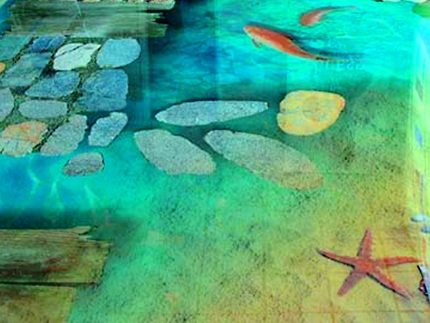
For the bathroom in the first place - water resistance, thanks to which a beautiful decorative coating in the bathroom will last 10 or even 15 years without repair
If you follow the filling instructions, observe the time intervals for drying and do not start to exploit the floor ahead of time, strength will reach a level where abrasive powders, sharp objects and aggressive chemical environments are not terrible.
This means that accidentally spilled bleach will not cause damage to the decorative coating, and the fallen scissors will not leave scratches.
Methyl methacrylate
Polymethyl methacrylate, better known as plexiglass, has been improved and has been successfully used as liquid floors. At first sight, better material for a bathroom not to find - it serves up to 40 years, it is considered the most wear-resistant of liquid coatings.
Its strength is such that this material is chosen for the construction of garages, shops, warehouses. It easily carries overloads and is not afraid of any impact: chemical, temperature, ultraviolet.

A property that will appeal to lovers of quick repair: the process of pre-hardening lasts only 2 hours - the material dries so fast (under the conditions of pouring)
It would seem that the solution is just perfect! However, not all so simple. There are a number of technological subtleties, without knowledge of which repair can not begin:
- requires a professional knowledge of the skills of the filling floor, because the fill must be done promptly and without flaws (due to rapid drying);
- good ventilation in the bathroom is necessary - the chemical smell is not only unpleasant, but also harmful to health (for the same reason - mandatory use of overalls and a respirator);
- there are about 30 basic colors, plus toning with color and chips, but still, according to the variety of the palette and, if possible, the decoration, methyl methacrylate floor is inferior to the analogues.
It turns out that for industrial applications better option not found, but in the home, methyl methacrylate should only be dealt with by specialists.
For the experimentally decided small advice on the choice of the material: having bought the components of the domestic manufacturer, you will spend money 3-4 times less. For composites and dry mixtures manufactured in Russia, components are purchased abroad, so they are not inferior to foreign analogues.
Epoxy
The technology of pouring epoxy floors does not differ from previous ones, the difference is only in the components. The resin hardens under the influence of the hardener and forms a very strong seamless layer. The solution is usually prepared in small portions, since within an hour ready mix should be distributed over the planned site.
The drying time depends on the temperature, humidity, the set of components and the texture of the substrate.
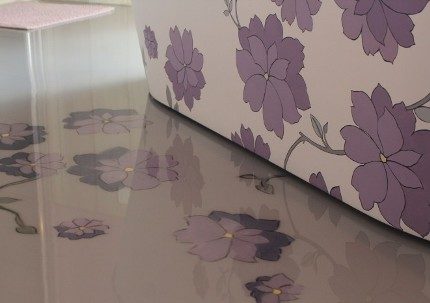
A pattern or pattern is produced as follows: the finished image is placed on the lower base layer, then filled with a transparent or translucent, rapidly solidifying solution
For strength and durability of epoxy coatings are not inferior to polyurethane, but crystallized epoxy resin is inherent in some brittleness. For this reason floors of this category are not used, for example, in rooms where heavy equipment works.
For the bathroom, the option is suitable, since the surface of the epoxy layer does not react to the effects of chemicals and is resistant to moisture.
If you like to experiment with a decor, then epoxy resin coatings are a real find. With their help, you can implement a wide variety of designs:
- monochrome contrast patterns;
- 3D coatings with images of marine animals, floral cascades;
- imitation of precipice, waterfall, cloudy sky;
- jewelry macro decor;
- colored fillings with chips;
- neutral glossy and matte coatings.
A variety of shades is reflected in the color charts and RAL tables, which are attached to the products of a particular manufacturer in the form of folders and fans.

Approximately 15-30 colors are usually declared as standard, but by mixing the base with the color you can achieve exactly the shade that you need
Self-leveling floor: brief instructions
It makes no sense to give a general instruction on the device of liquid floors, because, depending on the components, the order and conditions of filling may differ. For the sample, we describe the process of creating an economical filler coating that quickly solidifies and is universal.
With one version of the device flooring can be found here:
Selection of materials and tools
As the main material for filling the floor in the bathroom, we take a one-component dry mix "Leveler Express" from the company "Volma", which serves to level the concrete floor and is an excellent basis for laying ceramic tiles or a decorative polymer coating.
You can choose a cement or gypsum option, in both cases, the mixture will include synthetic modifying fillers and binders that allow the solution to "self-level".
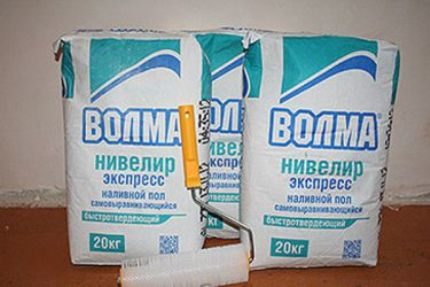
The cost of one bag is 4,5-5 $, which is cheaper than analogues of foreign manufacturers (Ceresit or Knauf). For bathrooms typical urban housing will require 3-4 bags of dry mix, that is, the main material will cost no more than $ 20
Characteristics of the mixture:
- the width of the working layer is 8-10 mm;
- bond strength - 2 MPa;
- the initial setting period is 5-6 hours;
- time of full maturation - 7-10 days;
- packing - kraft bags 20 kg.
In addition to the dry mixture, a primer (for flooring, deep penetration) is required, and if this layer is planned to be made sole - the final fixing coating.
Instruments:
- a vacuum cleaner;
- solution tank:
- a drill with a mixer nozzle;
- brush or roller to distribute the primer;
- wide mortar spatula;
- needle roller with telescopic handle.
How to calculate the consumption of the material? With a layer thickness of 10 mm per 1 m², 12.5 kg of dry mix is required. Suppose that the area of your bathroom is 4 m², which means 12.5 x 4 = 50 kg. Therefore, you will have to buy 3 bags "Level of Express".
Surface preparation
Often, the concrete coating in new and old houses is uneven, covered with cracks, so the surface of the floor must be thoroughly cleaned.
To do this, remove construction debris, expand the cracks (if any), mask large grooves and holes with cement mortar, grind a relatively flat surface, and at the end - vacuum cleaner. Self-leveling floors like a perfectly clean and smooth base: the smoother it is, the less the layer of solution and the better the coverage.
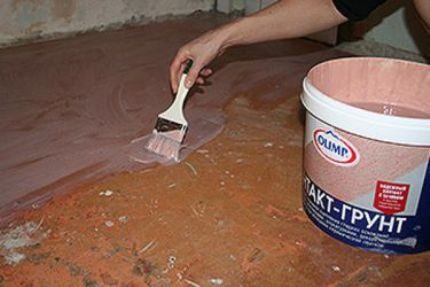
When choosing a primer, be guided by the manufacturer: materials of the same brand are better in contact with each other, which affects the strength of the coating
One of the nuances of the technological process of the device of any multilayer coating is the drying period. Priming, as well as the main material, takes time to completely dry (indicated in the explanation on the package).
To dilute the mixture, it is better to take water at room temperature, hot use is not recommended, since the pour time will dramatically decrease. The amount of water depends on the volume of the mixture, approximately 20 liters, approximately 6 liters of water are needed. If you prepare the solution in parts, then water, respectively, need less (10 kg - 3 liters, etc.).
The bathroom of a large area is better divided into technological zones, as it is unlikely that you will have time to fill the entire surface immediately.
In the container (a bath, a basin, a tank) we pour water, and then gradually, not one portion, we fall asleep the necessary volume of a mix. The technology involves mixing twice. The first time in 5 minutes after the dry powder completely absorbs water, the second time - 5 minutes after the first mixing.
It is necessary that all components, including fine fillers and plasticizers, are dissolved.
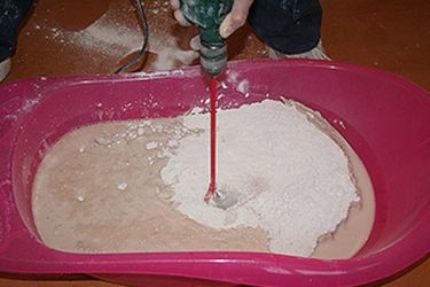
To mix the solution, a construction mixer or a drill with a special nozzle is suitable. Homogenization provides only a thorough mixing of components, so the "stick" that lovers like to use is not good enough
There is a practical way to check the optimal density. One liter of the solution is poured onto the floor - if a circle with a diameter of 0.5-0.6 m was formed, then the mixture is prepared correctly.
Filling order
Despite the fact that the mixture is self-leveling, it can be "helped" with a wide spatula, distributing the composition along the length and width. This method helps to control the thickness of the layer, making it optimal (up to 10 mm).
If the room is large, an assistant will be needed, due to which the pouring time will be halved: one prepares the solution, the other distributes it over the surface.
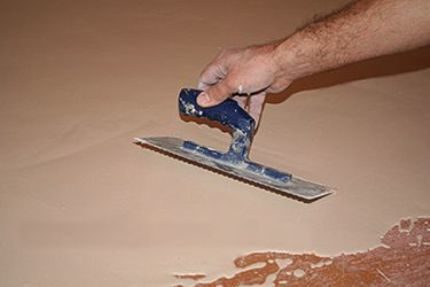
If the surface does not immediately get smooth, do not try to level it with a spatula to the ideal state - after a few hours, when the whole room is flooded, the solution will be leveled out on its own
We apply the solution squares or stripes along a long wall, as a result, individual fragments merge and form a monolithic coating. However, work should be done as quickly as possible, since the homogeneity of the mass is a pledge of an attractive appearance (which will be necessary if the floor is left without ceramics).
To expel air bubbles from the solution, use a needle roller with a long handle.
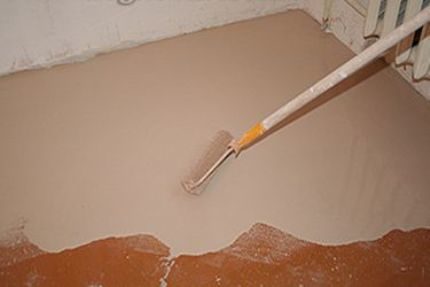
The larger the area of the bathroom, the wider the roller, for a typical bathroom a 20-30-centimeter tool is sufficient. The length of the studs depends on the thickness of the working layer
It is possible to level and fill the finished solution for an hour, until crystallization occurs. If there are no special skills, better prepare the mixture in small portions. Make sure that windows and windows are closed in the whole apartment, otherwise the floor surface will be covered with small cracks from the draft.
After about 4-5 hours the bulk floor you can walk, 2-3 days later - laying ceramics, and for installing laminate and linoleum it is better to wait about a week. With the installation of heavy furniture and sanitary ware is also better to wait.

The finished result - the bulk floor "Volma" - looks presentable and without further processing, so when small area bathroom can completely do without decor or clothe solution under the color of the walls
Time to dry: is it worth adjusting the process
The quality of the floor for the bathroom depends on the filling rules, among which is the drying time of each layer.
If you take into account the general factors, then for a period of complete drying affect the temperature and humidity in the room, the presence of drafts and sunlight (if the bathroom has a window), the type of solution, single or multi-layer, the thickness of each layer.
It is necessary to distinguish the time necessary for the ability to move around the freshly-ground floor, and the period of complete drying-there is a considerable gap between them.
The principle is the same as for the device cement screed: a layer 10-15 mm thick already within 5-6 hours without deformation can withstand the weight of a person, but full availability only occurs on day 4-5.
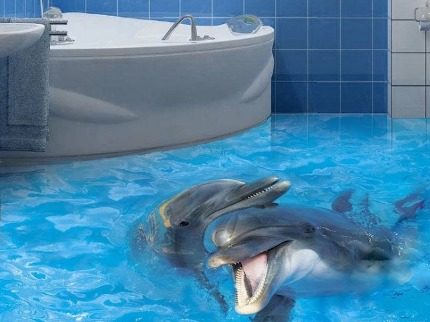
Filling 3D floors are powerful only for professionals, so beginners are better at experimenting with a lighter decor. For more complex design, we advise you to contact specialists
Speed up drying does not make sense, and the opportunity is not provided. Methyl methacrylate mixtures and so crystallize very quickly - after 1.5-2 hours, and the remaining types of solutions must "mature" in a natural way, even if the process takes several days.
Otherwise, the coating will lose its most important characteristics - strength and durability. If you need an urgent repair, we recommend quick-drying mixtures.
Drying conditions:
- air humidity - 60-65%;
- air temperature - 22-24ºC;
- no drafts (doors and windows must be closed);
- protection from ultraviolet radiation;
- compliance with the thickness of the layer.
These averaged figures and rules, the instructions for dry mixtures and composites indicate the exact parameters, and they need to be followed.

The table shows the approximate drying time of the mixtures in the cement and polymer base - from 2 hours (possibility of walking) to 4 weeks (full availability)
If you purchase the necessary mixtures, carefully study the instructions and fulfill all the conditions of pouring, in two weeks in your bathroom there will be a beautiful floor in the style that you prefer.
When repairing the floor screed in the bathroom is a very important stage. Especially it concerns old type houses. How to fill the screed with a tile? Thanks to the screed in the bathroom, you can achieve the best load distribution of plumbing and furniture on the floor. And the impact of small leaks can be minimized.
Substrate preparation
People who believe that before you fill the floor, you just need to remove the old floor, are mistaken. Removing the rough floor is just the beginning of the floor pouring process. Fiber of old screed and disposal of garbage in the process repair work - the easiest, with what you can encounter during repair. The entire process of replacement and installation of the screed consists of a number of works, one of the most important of which is waterproofing. It is carried out after dismantling the old floor and thoroughly cleaning the base.
All even the smallest mote must be removed. Then all communications are put in and all the cracks are covered, if any.
Preparing the floor for screedThe prepared surface should be flat, as well as the layer of the laid screed, otherwise it may crack over time, which will lead to a lot of additional hassle.
Waterproofing the floor, made of high-quality materials, will eliminate the risk of flooding neighbors with the slightest leakage for years to come. Some people assume that installing a waterproofing is sufficient for laying a polyethylene film. This is fundamentally wrong! This material is waterproofing for a couple of years, after which it is gradually eroded by cement, which will be contained in the screed. Therefore, to avoid water leakage to neighbors, waterproofing should be carried out using roll materials and bitumen mastic.
 Tools for floor screed
Tools for floor screed Step-by-step actions how to implement:
- first clean the slabs - then ground them;
- on each side a wooden beam or a special T-shaped profile is required, forming a beacon. Each wooden or profile beacon should be evenly arranged according to the level of the screed height. All lighthouses can both be left and dismantled before installing the screed. If there is a desire to leave them - every wooden bar is treated with means against moisture and rot, and metal - with anti-corrosion;
- then a layer of bitumen or other waterproofing material is laid on the slabs. Can be used roll rubberized waterproofing;
- covering the floor waterproofing material, they should be treated with about 15-20 cm of walls so that visually the waterproofing layer creates a semblance of a "trough". Especially carefully should work out the area of the risers and ceilings.
 Waterproofing the floor before the screed tile
Waterproofing the floor before the screed tile | Types of waterproofing | |
| Material | Application |
| Cement and polymer | This universal mixture is used for waterproofing the roof and floor. Only the use of combined compounds today has practically replaced the use of cement-polymer materials. |
| Bitumen | One of the most economical materials for waterproofing. It has been used since the time of Soviet construction. Cold type of waterproofing is better not to use because of contact with alkali concrete. The use of hot bitumen is more appropriate in pouring the bathroom floor in a private house than in an apartment because the finished material can be heated to 160 ° C. |
| Bitumen and polymer | Thanks to latex fillers and plasticizers, the mastic perfectly adheres to the concrete. In this case, this type of waterproofing is very strong. |
| Acrylic | This type of water-based waterproofing has no unpleasant odor, is ductile and durable. Also, it does not collapse under the influence of concrete and has a special durability. |
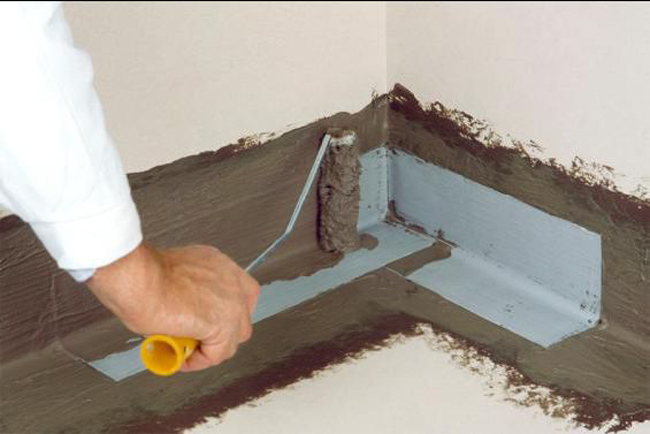 Particular attention during waterproofing should be given to the corners
Particular attention during waterproofing should be given to the corners It is worth noting that the floor screed in the bathroom can be of several types, but in any case the main components will be:
- water;
- sand;
- cement;
- crushed stone;
- for strengthening - perlite, expanded clay.
For the floor in the bathroom can be used wet, dry or half dry screed, each of which must be flat. Therefore, before it is poured it is very important to set up the lighthouses correctly.
Beacon Installation
The correct installation of lighthouses and floor screed in the bathroom is good because final stage the floor is absolutely smooth, so the costs of tile adhesive are minimized. Lighthouses in most cases can be installed using a two-meter lath level. Lighthouses are installed in slides along the wall with a step of about half a meter. They are pressed into the solution, controlling the level of the position. All beacons are set equally with respect to the first. Between the first and the subsequent should be formed a clear horizontal.
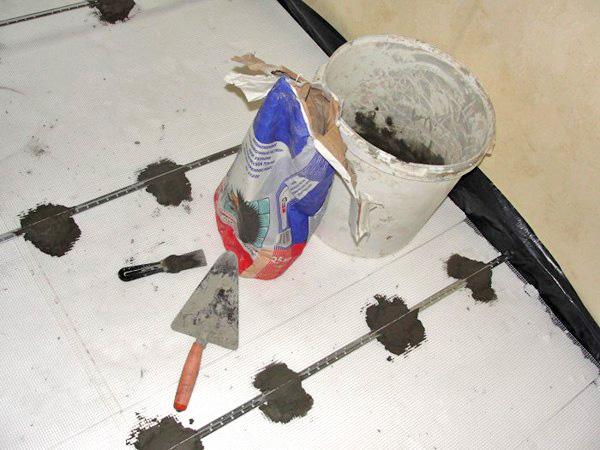 Beacon Installation
Beacon Installation If the coupler needs to be poured onto the foam, then it is cut out at the locations of the lighthouses. Otherwise, the beacons will not be able to be set evenly on the level, so laying the tile will be much more difficult.
Be sure to make sure that the thickness of the screed is not less than half a decimeter. This is especially important if it is poured over foam - its thinner layer can quickly crack. Checking the height of the installed beacons, which is measured from the plates to the ceiling, you can install metal or wooden beacons, and then proceed to pour the screed, the technology of which you should also know.
How to make a screed depending on the type
There are several types of screeds, differing in the way of arrangement, used materials.
Semi-dry
In the manufacture of semi-dry screeds it is desirable to use special aggregates, by means of which an additional reduction of the load on the floors in the bathroom is carried out. In comparison with a wet screed, it costs more, but it dries much faster. First mix the mixture, distribute it on the floor, and after it has dried - rubbed to remove all the irregularities and bumps.
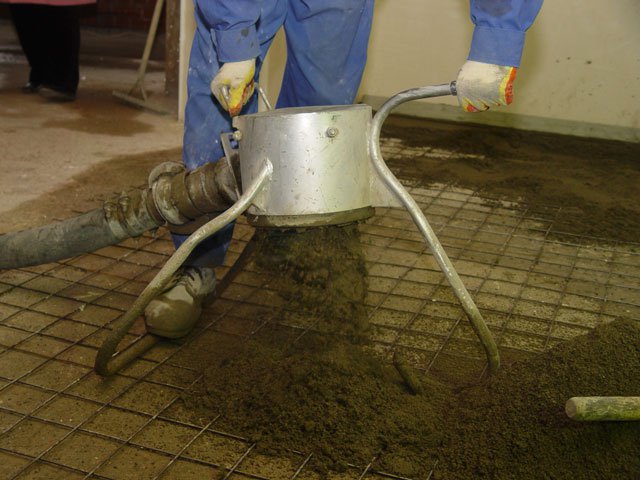 Semi-dry screed
Semi-dry screed Before you start pouring the screed, you should calculate everything in such a way that the height of the floor in the bathroom does not exceed the height of the floor in other areas of the living space, and was even slightly lower. It is equally important to correctly calculate the necessary amount of materials for the preparation of the solution. If the cast concrete is to be poured, then it is safe to use a proportion of 1 part of cement to 4 sand. In the case of pouring the prepared solution over the foam, the ratio will be 1 to 3, where 1 part is cement and 3 sand.
The resulting solution is poured into the prepared area and leveled with a level. Each time, a strip after a strip, is poured and the solution is leveled until necessary height. After it, you need to let it dry for at least a day, after which - remove the guides, and fill the empty places formed with cement mortar. For pulling lighthouses it is better to use wide shields. They contribute to the gentle extraction of lighthouses, as a result of which the floor will not crack.
Then the screed is cleaned until the whole surface is perfectly even. After it is covered with polyethylene to reduce the rate of water evaporation and increase the concrete strength, it is allowed to dry. On the floor it is better not to walk for at least a couple of days. After completely drying the floor, you can start laying the tiles.
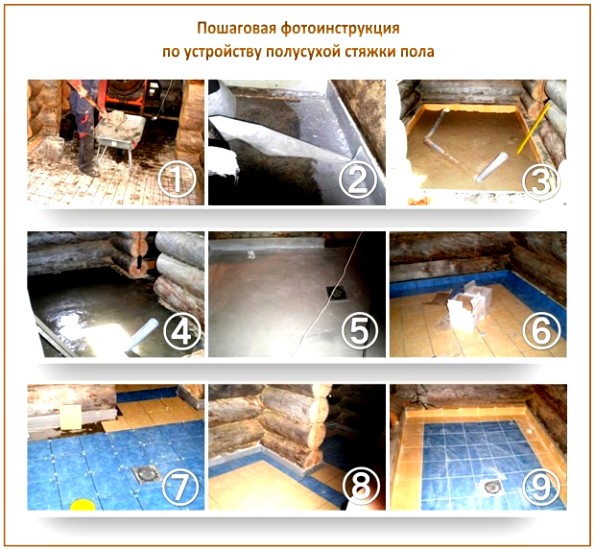
Wet
Wet - perfect solution for rooms with high humidity. Before choosing this type of flooring, it should be noted that the thickness of the wet screed is at least 3 cm. Therefore, dry or semi-dry couplings are preferable to wet if the bathroom has low ceilings. The advantage of a wet screed is the possibility of applying a waterproofing layer under it and over it. Under it, you can arrange a layer of thermal insulation.
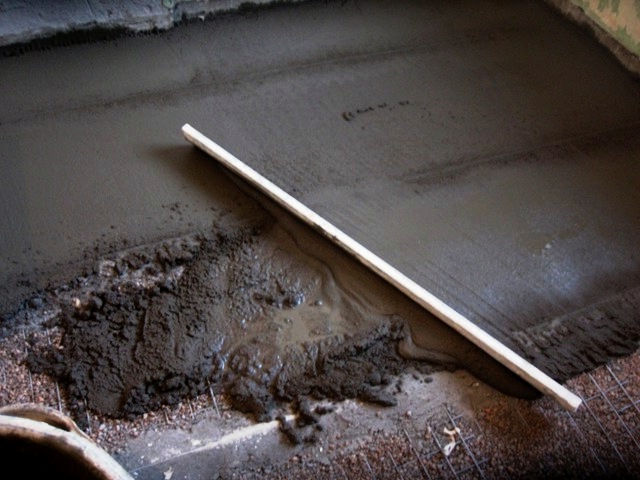 Wet screed
Wet screed When making a cement-sand mortar, 1 part of cement is required to 3 parts of sand. For hardening in the solution, you can add a bag of glue mixture for the tile. The finished solution should not be excessively flowing. Pour better to do in 1 approach, given that you can grasp the solution for an hour, after which it will be very difficult to level the floor surface. Filling is carried out layer by layer, each of which in some areas should be pierced with wire to release the collected air.
The next day, you need to remove the beacons, fill the empty space and align with the grout. Therefore, it is better to use a drywall sheet or chipboard to form reference islands. When the screed is dry, it should be polished with a Bulgarian. It is worth noting that it can dry for a week, and to accelerate the drying process is highly discouraged. To improve adhesion and adhesion, it is best to ensure that the humidity in the room is high. Within a month there should be no drafts in the bathroom, they, like overheating of the floor, lead to microcracks.
Dry
Dry screed requires special care. This is due to its gradual cracking due to constant contact with moisture. Therefore, in the bathroom it is extremely rare. Consumption of consumed materials is also much higher than with other types of screeds.
Dry screed is carried out in several stages. First lay layers of crushed stone and expanded clay, then cover with the mixture itself and moisture resistant materials. It should be noted that the dry screed has several advantages:
- it does not require a lot of effort;
- from her, in the bathroom and in the whole apartment, there is only dirt remaining;
- there is no need to cover with additional materials, you can immediately lay the tile.
Before filling, prepare the floor, fill the cracks with cement, and then apply waterproofing. Be sure to make sure that during the laying the water does not fall on the screed. If it is laid on a wooden floor - it is worth using cellulose paper impregnated with bitumen. The waterproofing layer should not be much higher than the level of the screed. For cushioning, heat-resistance and noise insulation, foam polyethylene can be used, the thickness of which is equal to the thickness of the screed, or mineral wool.
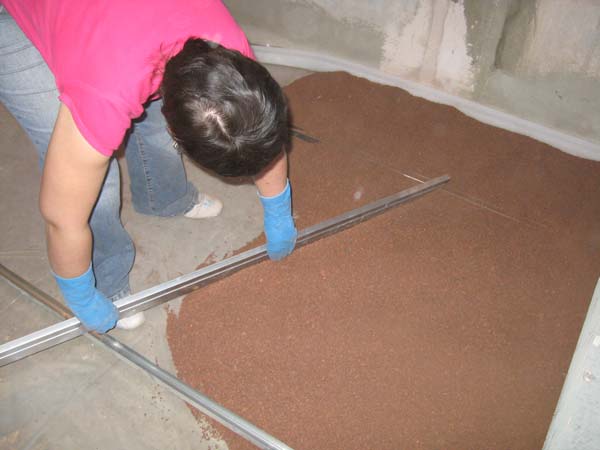 Dry screed
Dry screed The main material of dry screed can be sand from expanded clay. With the help of rake or rule, it is evenly distributed throughout the area. The thickness of poured claydite should be below the level by 20 mm. Further, the beacons are installed and proceed to leveling the surface from the far corners to the entrance door.
Next, mount gypsum fiber sheets (they are stronger than plasterboard), their laying starts from the entrance door. To fix them among themselves, use a seam edge and glue. Fix them with screws with a step of 50 mm in all places of joints. Then give to stand screed for 24 hours, install an additional waterproofing layer and proceed to finish and lay tiles.
National team
For the assembly screed you can use:
- gypsum-fiber sheets;
- plywood;
- oriented particle boards.
The assembly screed is installed only in a room with low or moderate humidity and at a temperature of at least 10 o C.
When assembling the assembly screed, the different slabs or sheets are laid in 2 layers on top of each other with offset joints. All the plates are fixed with glue and screws. Plates should be laid in such a way that between them and the walls there was a gap of up to 2 cm, filled with edge band.
Make a team screed in several stages. First lay the waterproofing layer, pour the expanded clay, rammer, level and lay one layer of sheets or slabs. Shift joints should not exceed 25 cm.
Each sheet of 2 layers is covered over the entire area of the glue, laying at least 25 cm offset with respect to 1 layer. Glue mastic can be used as a glue for gypsum-fiber materials. All sheets of 2 layers are fixed with screws. Then the joints are shpaklyuyut and primed. If tiled layers are laid, an additional waterproofing layer of pergamina should be laid between them and sand.
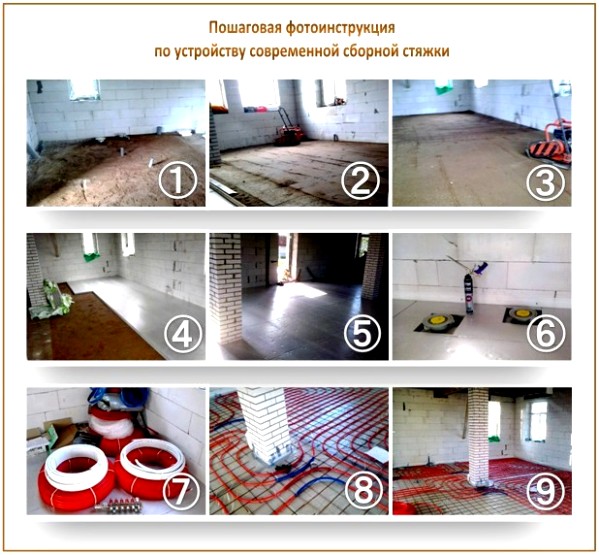
Floating
Floating type screed called independent. It is rigidly attached to the base and adjacent surfaces. The technology of installation of such a screed is simple, therefore its installation does not take much time. Thanks to this screed, heat is stored in the room and sound is isolated. Its leveling layer is practically not deformed.
It is advisable to mount such a screed with:
- installation on the soil of the rough layer;
- frequent contact with water;
- humidity and temperature changes, which often occur in the bathroom;
- installation of "warm floors";
- the desire to exclude the damage to the floor with a constant load on the coating.
When installing, first prepare the substrate by cleaning and washing it. When all defects are found, they are removed by filling with cement or polishing. Next, the floor is treated with antiseptics and begins to mark the screed. After the level of insulation and cement-sand mixture along the walls, 2 horizontal lines are carried out, which will help for perfect alignment of each layer.
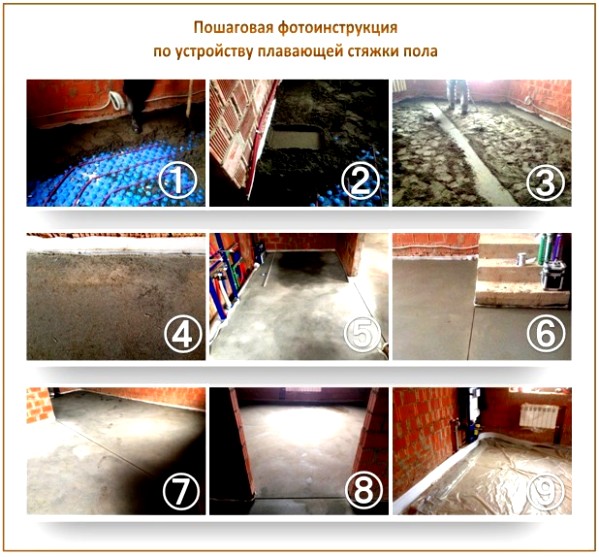
Waterproofing is best done with bitumen mastic. The material used must go to the wall. Further along the walls is installed a damper layer from the roll insulation. For sound insulation on the floor, it is possible to lay a foam plastic, sealing joints with adhesive tape, or pour claydite crumb. For reinforcement use reinforcing bars or metal mesh, distributing in the center of the floating layer. Further, the beacons are installed and the base is cemented.
After poured screed. The proportion of cement with sand is 1 to 4. To this mixture, to impart plasticity, it is better to add plasticizers. After pouring the mass, it is leveled. Then, to reduce evaporation and uniform drying, it is covered with a film. Each "penny" on the screed should be leveled, and after all its area.
Solid
It is better to make a continuous screed from a self-leveling mixture, however, gypsum or cement-sand is also suitable. If it is necessary to fill it in a bathroom with high humidity or in a private sector - experts recommend using cement sand in a proportion of 1 to 3. If you observe all proportions, the filled mass will dry quickly and will be strong and smooth.
With the help of such a mixture, it is possible to eliminate all irregularities reaching a height of 200 mm. The shrinkage of such a screed is quite long. It should also be noted that concrete floors are always cold, so when pouring cement-sand mixture it is desirable to lay heat-insulating layers. Pouring a continuous screed is recommended in the apartments of new buildings.
A continuous type of screed is considered one of the most common. Her production is as follows:
- first mix sand with cement;
- then water is added to the mixture until a characteristic "flop" is formed, however, it is impossible to overdo the liquid, as this can greatly affect shrinkage, leading to the formation of cracks as soon as possible;
- the resulting mass is poured onto the previously prepared floor and leveled.
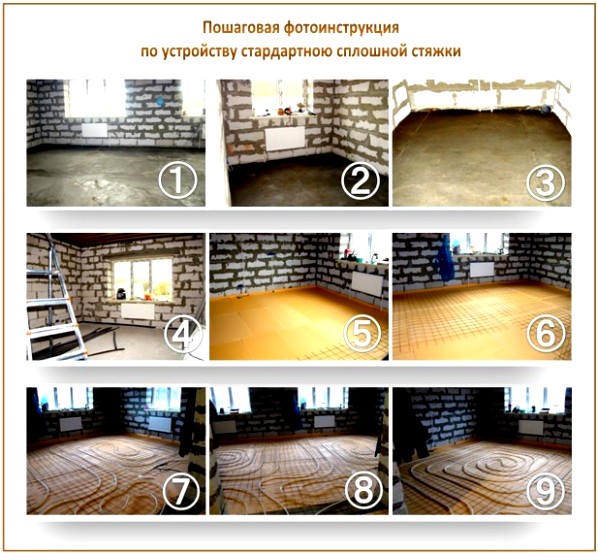
Installation of screed on wooden floors
An unbonded screed is installed on the wooden floor. For its preparation, a compacted film, cement M400, plasticizer and sand will be required. First, epoxy fillers or cement fill slits and cracks, joints are sealed with silicone. The prepared wooden floor is treated with a waterproof primer. On a wooden floor, regardless of the type of screed, it is better not to lay heat-releasing coatings and "warm floors" in order to increase the level of fire safety.

After that, a plastic film should be placed on the wooden floor. All joints should be pasted with adhesive tape. The material to be laid must be larger than the floor area in the bathroom, at least 7 cm on each side for allowances. After the beacons are exposed and the reinforcement is laid from the metal expanded mesh. Then, pour the solution and distribute it evenly over the entire area. The height of the screed must not be less than 50 mm.
What you need to consider:
- since the type of screed is unconnected, it must be very heavy;
- instead of the film, another waterproof material can be used;
- before pouring the screed onto the wooden floor, make sure that the film is tightly fastened;
- if there is a desire to lay a tile on a wooden floor using a screed - it is better to refuse this idea. Instead, it is better to cover the floor with a waterproofing or pergamon, then with DSP sheets, with a fiberglass or metal mesh, then prime and glue the tile using a special tile adhesive.
If you want to fill the screed on a wooden floor - to give a mixture of strength and plasticity, plasticizers should be used. Another advantage of this material is that it contributes to an additional reduction in water permeability. After pouring the screed it will be necessary to let it dry for at least a couple of days.




